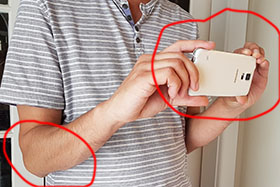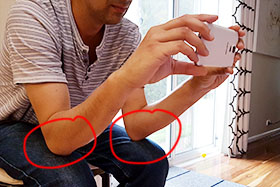How to Prevent Taking Blurry Photos of You Kids With Your Smartphone: Even if you have a child that never sits still
I understand how frustrating it can be when you see your child doing something sooo adorable that you just have to take a photo but the resulting photo just doesn’t live up to expectations. It’s either too dark or too blurry.
All you really want is just one respectable photo so that the memory of that moment will be recorded forever.
Scenarios like this happen all the time especially when you have a young child that constantly moves around so fast that anyone would think you’ve got them on a diet of red cordial for breakfast, lunch and dinner. How on earth can you ever possibly get a decent photograph?
.jpg)
Well thankfully there are certain things you can do to improve your ‘photo-keeper’ success rate and I’m here to share some of those tips.
When I sat down to write this article I asked myself one question, how can I give you the information that you need without being boring and avoid using too much technical jargon?
So I decided to split the tips into two section – the first part includes some easy action steps while the second involves playing around with your phone camera settings (but not too much – you don’t need to be a whizz).
The main goal of each section is for you to come away with information that you can use immediately to improve the photos you take of your kids. More specifically how you can reduce the number of blurry photos you take, especially if your child is always moving and never sitting still.
Keep in mind these tips are written for parents who use their phones to take photos rather than a dedicated camera. However a lot of the principles can be used for both.
In this first section let’s talk about some simple things you can do straight away to reduce the number of blurry photos you take.
Simple Practical Tips for Eliminating Blurry Photos of Your Kids
Working with your kids
1. Give them something to do
A sure fire way of stopping your kids from moving around is to have them engage in some form of activity. Some of the most adorable photos are captured this way because your child is lost in their own imagination. These are the photos you will love to look back on when they are older because their interests are always changing depending on what stage of development they are in.
TIP – quietly take a lot of photos while they are immersed in the activity. When you are done, have the camera ready and gently call out their name so they look at you. Now you have a photo of them looking at you without going through all the hoo-ha of calling out their name a hundred times over and asking them to smile at the camera.
In the photo below, my daughter Aria, was more interested in sucking her toes than avoiding the camera.
.jpg)
2. Be patient
Have you noticed the more eager you are to take a photo of your child the more determined they are not to cooperate?
Be patient when it comes to taking their photos. Don’t chase them around or constantly try calling out their name to get their attention. All this does is rile them up, they then won’t stay still and you will end up with the perfect blurry photo.
Sometimes if you are patient enough they will come to you. Ha ha [evil laugh], is that called reverse psychology photography?
3. Let there be {MORE} light
Your blurry photos are caused by either your camera shaking, your child moving or not enough light or a combination of any of these three.
Below I talk about combating camera shake and your child moving. However if there is not enough light in the room you will inevitably take blurry photos.
So what should you do? Well, ideally you should open up all the blinds and let in as much light as possible. Without ruining the moment, set up the photo by positioning your child closer to the window.
I don’t want to get too technical but just remember that the more light you have the more chance your photos will be sharper.
**If you really want to learn why this is [yes, the techy stuff] then you can read about it at the end of this article.
Sometimes you might want to use the flash on your phone. I would suggest using flash as a last resort. Yes, your photo may be sharp but your camera’s flash tends to ruin photos rather than saving them (refer to video below).
I created a short video about blurry photos, opening up the blinds and using flash. You can watch it below.
Simple Camera Techniques to Help Eliminating Blurry Photos of Your Kids
1. Clean your camera lens
Seriously, yes. One oily fingerprint on your lens can give your photos a soft, blurry look. When was the last time you actually looked at your phone and how dirty it was?
Yuck, right.
Spend 5 seconds and wipe your lens with your shirt before taking any photos.

2. Don’t zoom in
If you need to get closer to your child to take that amazing shot, don’t pinch the screen to zoom in. The more you zoom in using this technique the lower the quality your photo will be in both resolution and sharpness. This is not a true zoom. I’m not going to cover the reasons why (remember no techy discussions here).
If you need to get closer, use your feet and move in.
.jpg)
3. Support your phone
Is it just me or do you also find that when you use one hand to take a photo the phone shakes and moves a lot. Especially if you are using your free hand to press the round button on the screen to take the photo.
For sharper photos your camera needs stability. When composing the photo use two hands to steady the phone and use one of your fingers to press the phones side buttons to take the shot.
Note – depending on the phone you may need to go into your camera settings to configure a different button to take a photo.
Other things you can do to steady your phone before taking the photo:
* push both of your elbows into your torso
* rest your elbows on your knees
* lean up against some form of support – like a wall

Two hands & elbows tucked in

Use your knees as support
Let’s Get a Little (Not Too Much) Techy
OK, I did say that this article was going to be split up into two parts. The next section requires you to adjust a few phone camera settings.
Be familiar with your phones camera setting
Now don’t freak out. I’m not telling you to learn everything your phone camera can do. Just the few things listed below. Practice how to access the settings and change them quickly so that it becomes second nature and you’re not fumbling around when you really need to use them in a hurry.
.jpg)
Learn to:
* Turn on professional mode in camera (maybe called something else in different phones)
* In Professional mode learn how to adjust ISO
* how to adjust shutter speed
* how to set auto focus lock
* how to focus manually
Below I discuss why the above features are important and how they can help you to reduce the number of blurry photos.
A simple Youtube search with your phones make/model and the above keywords should give you a lot of short easy to follow videos that will show you where to access these features on your phone.
Pro Mode / ISO / Shutter speed
Once you can change the mode of your phone camera to PRO(fessional) you can now start taking control of your photos and reduce the number of blurry photos you take.
1. Shutter speed
The shutter controls the amount of light in your photo (the exposure). Shutter speed is measured in seconds. Basically, the shorter the time your shutter is open the less chance of your subject moving and hence your subject is sharper.
So 1/200th is shorter than 1/25th of a second.
Adjust your shutter speed manually to something faster. It’s impossible for me to tell you what it should be as it all depends on the amount of light around you.
Notice that as you increase your shutter speed your screen gets darker because less light is entering your camera.
Let’s compensate for this…
.jpg)
2. ISO
ISO changes the sensitivity of your camera to light. A higher ISO value will make it more sensitive and will therefore make your photos brighter.
Again, in Pro mode you can manually change your ISO.
Now that we have darkened your photo by making the shutter speed faster in the previous step. Increase your ISO to make the scene on your phones screen bright again.
That’s it you’re done.
All things being equal, the photos you take with these settings should be sharper as the shutter speed is faster.
Sharper Focusing – Auto-focus Lock
Most phone cameras have a setting called auto-focus lock or continuous focus. This is perfect for photographing your kids when they are moving because the camera tracks your child’s movement as they move around the scene’s frame.
You can activate this on most phone cameras by pressing and holding your finger on the area where you want it to lock focus (your child’s face). The feature when active might say something like “AF lock”. Again it depends on your phone’s make and model so look it up if unsure.
With auto-focus lock on, your child will stay in focus as they move around the room.
Watch the video below to see auto-focus lock in action.
Manual Focusing
Sports photographers are always faced with the challenge of fast moving subjects. One technique they use is manual focusing. How this works is that they manually focus on a set spot where they anticipate the action to be. They then wait for the action to come to them and then take the shot.
Have you ever noticed that when you try to photograph your child you tend to miss a lot of your photo opportunities because you waste a few seconds trying to focus?
Well you can use manual focus to overcome this.
.jpg)
If manual focus can be used to freeze a greyhound you can do it with your kids too
Once again put your camera into Pro mode and change it to manual focusing. Pre-focus the camera on a set area. If your child is stationary start taking as many photos as you like without running the risk of your phone randomly choosing something else in your scene to focus on.
If your child is moving, wait for them to come in to the pre-focused zone before taking your photo. Now that you don’t have to focus every time (because you already pre-focused) you will not miss out on any shots.
Alternatively, you can follow your child around the room while you are in manual focus mode. This is a lot harder to master because it only works if the distance between you and your point of focus (your child) remains the same. Given how fast children move I wouldn’t recommend this technique.
Conclusion
That’s it. You are now armed with several easy but effective techniques that you can use to start taking sharper photos of your children. The only way to nail it every time is to practice. However, if you love photographing your kids as much as I do, you will have plenty of practice opportunities.
I would love to receive some feedback on the techniques discussed. Let me know in the comments below, especially if you start to use them with success.
P.S.
Earlier, I promised that I would discuss some technical aspects about shutter speeds for those of you who really wanted to get a bit geeky. So, this section is for those of you who want to understand why more light equals sharper photos.
If we start of on the basis that no matter what the light in your scene is like – either very bright or very dark, your camera will try to compensate by attempting to give you a correct exposure. Our phone cameras do this by changing the shutter speed and ISO automatically.
It’s the shutter speed setting that effects how sharp or how blurry your photos will be. The shutter is what allows light into the camera.
If the light is low, your camera needs more light to make a properly exposed photo. So to do this it keeps the shutter open longer. However the longer the shutter is open the more opportunity for blurry photos because either your subject moves slightly or you move the camera while the shutter is open.
This is why you should have as much light in your scenes as possible when photographing your children. Your camera will select a faster shutter speed and then there is less chance of blur.
Shutter speed is measured in seconds. Most times you will see it written as a fraction of a second. For your reference if I am hand holding my camera I personally find it hard to take sharp photos if the shutter speed is over 1/20th of a second. Sports photographers use shutter speeds as fast as 1/500th and beyond. For your child try setting you shutter speed to more than 1/100th of a second.






